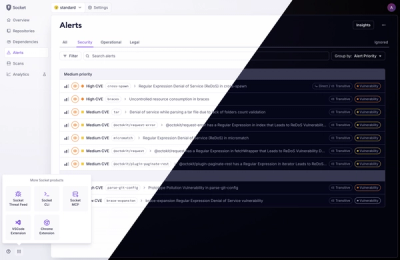
Product
A Fresh Look for the Socket Dashboard
We’ve redesigned the Socket dashboard with simpler navigation, less visual clutter, and a cleaner UI that highlights what really matters.
react-aria-menubutton
Advanced tools
A React component (set of components, really) that will help you build accessible menu buttons by providing keyboard interactions and ARIA attributes aligned with the WAI-ARIA Menu Button Design Pattern.
Please check out the demo.
"Useful modularity" means that when it makes sense, chunks of lower-level code that solve specific problems are split off into vanilla JS, framework-agnostic modules that could be shared with other similar projects (e.g. a menu button for Angular or Ember).
For this library I was able to split off:
If you like this kind of module (accessible, flexible, unstyled, with framework-agnostic low-level modules) you should also check out these projects:
The project started as an effort to build a React component that follows every detail of the WAI-ARIA Menu Button Design Pattern for maximum accessibility.
Just hiding and showing a menu is easy; but the required keyboard interactions are kind of tricky, the required ARIA attributes are easy to forget, and some other aspects of opening and closing the menu based on behaviors, and managing focus, proved less than pleasant. So I decided to try to abstract the component enough that it would be worth sharing with others.
If you think that this component could be even more accessible, please file an issue.
When focus is on the menu button or within the menu and you type a letter key, a search begins. Focus will move to the first item that starts with the letter you typed; but if you continue to type more letters, the search string extends and the focus becomes more accurate.
So if you type f focus might arrive at farm; but then if you keep typing until you've typed foo, focus will skip ahead (past farm and fit and fog) to foot. This significantly improves your ability to type your way to your intended selection.
This keyboard interaction (as well as the home, end, and arrow keys) is enabled by the module focus-group. You can read more about the way letter navigation works in that documentation.
(In 3.x.x, when you typed a letter key focus moved to the next item in the menu (i.e. after the current focused item) that started with that letter, looping around to the front if if reached the end. This was more or less the suggested behavior from the ARIA suggestion and what I saw in jQuery UI. But I think the UX was insufficient, so when I separated out the letter navigation into the module focus-group, I tried to *improve letter navigation by more closely mimicking native <select> menus.)
Please file an issue if anything is unclear or doesn't work as expected.
Instead of providing a pre-fabricated, fully styled widget, this module's goal is to provide a set of components that others can build their own stuff on top of.
It does not provide any classes or a stylesheet that you'll have to figure out how to include; and it does not include inline styles that would be hard to override. It only provides "smart" components to wrap your (dumb, styled) components. The library's components take care of keyboard interaction and ARIA attributes, while your components just do whatever you want your components to do.
npm install react-aria-menubutton
The modular approach of this library means you're much better off building it into your code with a module bundling system like browserify or webpack.
But if you need a UMD version (which will include focus-group and teeny-tap in the bundle, but of course not React or ReactDOM), you can get it via npmcdm at https://unpkg.com/react-aria-menubutton@[version-of-choice]/umd/ReactAriaMenuButton.js.
If you don't know about unpkg, read about it here.
Basically IE9+.
const AriaMenuButton = require('react-aria-menubutton');
// Now use AriaMenuButton.Wrapper, AriaMenuButton.Button,
// AriaMenuButton.Menu, and AriaMenuButton.MenuItem ...
// ... or with es2015
import { Button, Wrapper, Menu, MenuItem } from 'react-aria-menubutton';
For details about why the examples work, read the API documentation below.
You can also see more examples by looking in demo/.
// Very simple ES2015 example
import React from 'react';
import { Wrapper, Button, Menu, MenuItem } from 'react-aria-menubutton';
const menuItemWords = ['foo', 'bar', 'baz'];
class MyMenuButton extends React.Component {
render() {
const menuItems = menuItemWords.map((word, i) => {
return (
<li key={i}>
<MenuItem className='MyMenuButton-menuItem'>
{word}
</MenuItem>
</li>
);
});
return (
<Wrapper
className='MyMenuButton'
onSelection={handleSelection}
>
<Button className='MyMenuButton-button'>
click me
</Button>
<Menu className='MyMenuButton-menu'>
<ul>{menuItems}</ul>
</Menu>
</Wrapper>
);
}
}
function handleSelection(value, event) { .. }
// Slightly more complex, ES5 example:
// - MenuItems have hidden values that are passed
// to the selection handler
// - User can navigate the MenuItems by typing the
// first letter of a person's name, even though
// each MenuItem's child is not simple text
// - Menu has a function for a child
// - React's CSSTransitionGroup is used for open-close animation
var React = require('react');
var CSSTransitionGroup = require('react-transition-group/CSSTransitionGroup');
var AriaMenuButton = require('react-aria-menubutton');
var people = [{
name: 'Charles Choo-Choo',
id: 1242
}, {
name: 'Mina Meowmers',
id: 8372
}, {
name: 'Susan Sailor',
id: 2435
}];
var MyMenuButton = React.createClass({
render: function() {
var peopleMenuItems = people.map(function(person, i) {
return (
<AriaMenuButton.MenuItem
key={i}
tag='li'
value={person.id}
text={person.name}
className='PeopleMenu-person'
>
<div className='PeopleMenu-personPhoto'>
<img src={'/people/pictures/' + person.id + '.jpg'}/ >
</div>
<div className='PeopleMenu-personName'>
{person.name}
</div>
</AriaMenuButton.MenuItem>
);
});
var peopleMenuInnards = function(menuState) {
var menu = (!menuState.isOpen) ? false : (
<div
className='PeopleMenu-menu'
key='menu'
>
{peopleMenuItems}
</div>
);
return (
<CSSTransitionGroup transitionName='people'>
{menu}
</CSSTransitionGroup>
);
};
return (
<AriaMenuButton.Wrapper
className='PeopleMenu'
onSelection={handleSelection}
style={{ marginTop: 20 }}
>
<AriaMenuButton.Button className='PeopleMenu-trigger'>
<span className='PeopleMenu-triggerText'>
Select a person
</span>
<span className='PeopleMenu-triggerIcon' />
</AriaMenuButton.Button>
<AriaMenuButton.Menu>
{peopleMenuInnards}
</AriaMenuButton.Menu>
</AriaMenuButton.Wrapper>
);
}
});
function handleSelection(value, event) { .. }
The module exposes four components: Wrapper, Button, Menu, and MenuItem. Each of these is documented below.
Button, Menu, and MenuItem must always be wrapped in a Wrapper.
WrapperA simple component to group a Button/Menu/MenuItem set, coordinating their interactions.
It should wrap your entire menu button widget.
All Button, Menu, and MenuItem components must be nested within a Wrapper component.
Each wrapper can contain only one Button, only one Menu, and multiple MenuItems.
All props are optional.
onSelection { Function }: A callback to run when the user makes a selection (i.e. clicks or presses Enter or Space on a MenuItem). It will be passed the value of the selected MenuItem and the React SyntheticEvent. You should definitely use this prop, unless your menu items are anchor elements.
<Wrapper onSelection={handleSelection} />
// ...
function handleSelection(value, event) {
event.stopPropagation;
console.log(value);
}
onMenuToggle { Function }: A callback to run when the menu is opened or closed. It will be passed the the following menu-state object:
{
isOpen: Boolean // whether or not the menu is open
}
For example:
const Example extends React.PureComponent {
constructor(props) {
super(props);
this.state = {
isOpen: false,
};
}
render() {
const openClass = this.state.isOpen ? 'open' : '';
return (
<Wrapper
className={`${openClass}`}
onMenuToggle={({ isOpen }) => { this.setState({ isOpen })}}
/>
);
}
}
closeOnSelection { Boolean }: By default, it does automatically close. If false, the menu will not automatically close when a selection is made. Default: true.
closeOnBlur { Boolean }: By default, it does automatically close. If false, the menu will not automatically close when it blurs. Default: true.
tag { String }: The HTML tag for this element. Default: 'div'.
ButtonA React component to wrap the content of your menu-button-pattern's button.
The Button component itself acts as a UI button (with tab-index, role, etc.), so you probably do not want to pass an HTML <button> element as its child.
Each Button must be wrapped in a Wrapper, and each Wrapper can wrap only one Button.
All props are optional.
disabled { Boolean }: If true, the element is disabled (aria-disabled='true', not in tab order, clicking has no effect).
tag { String }: The HTML tag for this element. Default: 'span' so styling across browsers is consistent, button is a good alternative if styling for that element is no issue.
Any additional props (e.g. id, className, data-whatever) are passed directly to the HTML element.
MenuA React component to wrap the content of your menu-button-pattern's menu.
A Menu's child may be one of the following:
a React element, which will mount when the menu is open and unmount when the menu closes
a function accepting the following menu-state object
{
isOpen: Boolean // whether or not the menu is open
}
Each Menu must be wrapped in a Wrapper, and each Wrapper can wrap only one Menu.
All props are optional.
tag { String }: The HTML tag for this element. Default: 'span'.
Any additional props (e.g. id, className, data-whatever) are passed directly to the HTML element.
MenuItemA React component to wrap the content of one of your menu-button-pattern's menu items.
Each MenuItem must be wrapped in a Wrapper, and each Wrapper can wrap multiple MenuItems.
When a MenuItem is selected (by clicking or focusing and hitting Enter or Space), it calls the onSelection handler you passed ariaMenuButton when creating this set of components.
It passes that handler a value and the event. The value it passes is determined as follows:
MenuItem has a value prop, that is passed.MenuItem has no value prop, the component's child is passed (so it better be simple text!).When the menu is open and the user hits a letter key, focus moves to the next MenuItem whose "text" starts with that letter. The MenuItem's relevant "text" is determined as follows:
MenuItem has a text prop, that is used.MenuItem has no text prop, the component's child is used (so it better be simple text!).All props are optional.
text { String } Required if child is an element: If text has a value, its first letter will be the letter a user can type to navigate to that item.
value { Any }: Required if child is an element. If value has a value, it will be passed to the onSelection handler when the MenuItem is selected.
tag { String }: The HTML tag for this element. Default: 'span'.
Any additional props (e.g. id, className, data-whatever) are passed directly to the DOM element.
Open a modal programmatically.
For this to work, you must provide an id prop to the Wrapper of the menu. That id should be your first argument to openMenu().
These are the openOptions:
true, the menu's first item will receive focus when the menu opens. Default: true.Close a modal programmatically.
For this to work, you must provide an id prop to the Wrapper of the menu. That id should be your first argument to closeMenu().
These are the closeOptions:
true, the widget's button will receive focus when the menu closes. Default: false.Please note that this project is released with a Contributor Code of Conduct. By participating in this project you agree to abide by its terms.
Lint with npm run lint.
Test with npm run test-dev. A browser should open; look at the console log for TAP output.
7.0.3
onSelection doesn't update on prop change issue #142FAQs
Did you know?

Socket for GitHub automatically highlights issues in each pull request and monitors the health of all your open source dependencies. Discover the contents of your packages and block harmful activity before you install or update your dependencies.

Product
We’ve redesigned the Socket dashboard with simpler navigation, less visual clutter, and a cleaner UI that highlights what really matters.

Industry Insights
Terry O’Daniel, Head of Security at Amplitude, shares insights on building high-impact security teams, aligning with engineering, and why AI gives defenders a fighting chance.

Security News
MCP spec updated with structured tool output, stronger OAuth 2.1 security, resource indicators, and protocol cleanups for safer, more reliable AI workflows.